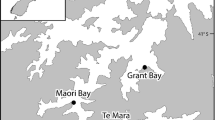Abstract
Marine reserves can help in maintaining biodiversity and potentially be useful as a fishery management tool by removing human-mediated impacts. Intertidal, soft-sediment habitats can often support robust recreational and commercial shellfish harvests, especially for clams; however, there is limited research on the effects of reserves in these habitats. In San Juan County, Washington, several reserves prohibit recreational clam digging. We examined the effects of these reserves on infaunal community composition through comparison with non-reserve beaches during a 6-week period. Clam abundance, overall species richness and total polychaete family richness were greater on reserve beaches compared to non-reserve beaches. Additionally, an experiment within a reserve demonstrated negative impacts of digging on non-target infauna. These effects probably resulted from local disruption and disturbance of the sediment habitat and not from increased post-digging predation, which was controlled. Intertidal reserves could play an important role in sustaining local and potentially regional biodiversity.







Similar content being viewed by others
References
Ambrose WG, Dawson M, Gailey C, Ledkosky P, O’Leary S, Tassinari B, Vogel H, Wilson C (1998) Effects of baitworm digging on the soft-shelled clam, Mya arenaria, in Maine: shell damage and exposure on the sediment surface. J Shellfish Res 16(4):1043–1049
Anderson FE, Meyer LM (1986) The interaction of tidal currents on a disturbed intertidal bottom with a resulting change in particulate matter quantity, texture, and food quality. Estuar Coast Shelf Sci 22(1):19–29
Babbock RC, Kelly S, Shears N, Walker J, Willis T (1999) Changes in community structure in temperature marine reserves. Mar Ecol Prog Ser 189:125–134
Banse K, Hobson KD (1974) Benthic and Errantiate polychaetes of British Columbia and Washington. Bull Fish Res Board Can 185
Blake JA, Hilbig B, Scott PH (1996) Taxonomic Atlas of the Benthic Fauna of the Santa Maria Basin and Western Santa Barbara Channel. Santa Barbara Museum of Natural History, Santa Barbara
Brown B, Wilson WH (1997) The role of commercial digging of mudflats as an agent for change of infaunal intertidal populations. J Exp Mar Biol Ecol 218:49–61
Byers JE (2005) Marine reserves enhance abundance but not competitive impacts of a harvested nonindigenous species. Ecology 86(2):487–500
Byers JE (2002) Physical habitat attribute mediates biotic resistance to non-indigenous species invasion. Oecologia 130:146–156
Clarke KR, Gorley RN (2001) Primer v5. PRIMER-E Ltd
Collie JS, Hall SJ, Kaiser MJ, Poiner IR (2000) A quantitative analysis of fishing impacts on shelf-sea benthos. J Anim Ecol 69:785–798
Dethier MN, Ferguson M (1998) The Marine Habitats and Biota of Westcott and Garrison Bays, San Juan Island. Report submitted to the San Juan County Planning Department, WA, USA
Dethier MN, Schoch GC (2005) The consequences of scale: assessing the distribution of benthic populations in a complex estuarine fjord. Estuar Coast Shelf Sci 62:253–270
Dernie KM, Kaiser MJ, Warwick RM (2003) Recovery rates of benthic communities following physical disturbance. J Anim Ecol 72:1043–1056
Fauchald K (1977) The polychaete worms: definitions and Keys to the Orders, Families and Genera. Science Series 28. Natural History Museum of Los Angeles County
Fauchald K, Jumars PA (1979) The diet of worms: a study of polychaete feeding guilds. Oceanogr Mar Biol Annu Rev 17:193–284
Ferns PN, Rostron DM, Siman HY (2000) Effects of mechanical cockle harvesting on intertidal communities. J Appl Ecol 37:464–474
Folk RL (1974) Petrology of sedimentary rocks. Hemphill Publishing Company, Austin
Gell FR, Roberts CM (2003) Benefits beyond boundaries: the fishery effects of marine reserves. Trends Ecol Evol 18(9):448–455
Halpern BS, Warner RR (2002) Marine reserves have rapid and lasting effects. Ecol Lett 5:361–366
Hobson KD, Banse K (1981) Sedentariate and Archiannelid Polychaetes of British Columbia and Washington. Can Bull Fish Aquat Sci 209
Kozloff EN (1987) Marine Invertebrates of the Pacific Northwest. University of Washington Press, Seattle
Kozloff EN (1990) Invertebrates. Sanders College Publishing, Philadelphia
Lenihan HS, Micheli F (2000) Biological effects of shellfish harvesting on oyster reefs: resolving a fishery conflict using ecological experimentation. US Fish Bull 98:86–95
Meyer JJ, Byers JE (2005) As good as dead? Sublethal predation facilitates lethal predation on an intertidal clam. Ecol Lett 8:160–166
Nichols FH (1970) Benthic polychaete assemblages and their relationship to the sediment in Port Madison, Washington. Mar Biol 6:48–57
Pauly D, Christensen V, Guenette S, Pitcher TJ, Sumaila UR, Walters CJ, Watson R, Zeller D (2002) Towards sustainability in world fisheries. Nature 418:689–695
Puget Sound Estuary Program (1986) Recommended protocols for measuring conventional sediment variables in Puget Sound. U.S. Environmental Protection Agency, Region 10- Office Puget Sound
Skilleter GA, Zharikov Y, Cameron B, McPhee DP (2005) Effects of harvesting callianassid (ghost) shrimps on subtropical benthic communities. J Exp Mar Biol Ecol 320:133–158
Thrush SF, Dayton PK (2002) Disturbance to marine benthic habitats by trawling and dredging: implications for marine biodiversity. Annu Rev Ecol Syst 33:449–473
Thrush SF, Whitlach RB, Pridmore RD, Hewitt JE, Cummings VJ, Wilkinson MR (1996) Scale-dependent recolonizations: the role of sediment stability in a dynamic sandflat habitat. Ecology 77(8):2472–2487
Washington Department of Fish and Wildlife (2004) Shellfish regulations. http://www.wdfw.wa.gov/fish/shelfish/beachreg/faqs.html. Site visited 01-18-05
Washington Department of Fish and Wildlife (2000) Washington State Sport Catch Report. http://www.wdfw.wa.gov/fish/harvest/2000sport. Site visited 01-23-05
Woodin SA (1974) Polychaete abundance patterns in a marine soft-sediment environment: the importance of biological interactions. Ecol Monogr 44:171–87
Acknowledgements
Assistance in the field of Amy Glaub, Courtney Lyons, Jessica Harm, Abby Lunstrum, Marcos Toran, and Jenny Selgrath was greatly appreciated. Craig Staude helped with the sediment analysis. Thank you to all the MPA apprentices and the Friday Harbor Labs community for encouragement and support, and to the National Park Service for access to the English Camp Historic Site and English Camp National Park. A grant from the Mary Gates Foundation made this research possible. The experiments performed in this research complied with all current laws of the United States.
Author information
Authors and Affiliations
Corresponding author
Additional information
Communicated by P.W. Sammarco, Chauvin
Rights and permissions
About this article
Cite this article
Griffiths, J., Dethier, M.N., Newsom, A. et al. Invertebrate community responses to recreational clam digging. Mar Biol 149, 1489–1497 (2006). https://doi.org/10.1007/s00227-006-0289-1
Received:
Accepted:
Published:
Issue Date:
DOI: https://doi.org/10.1007/s00227-006-0289-1




